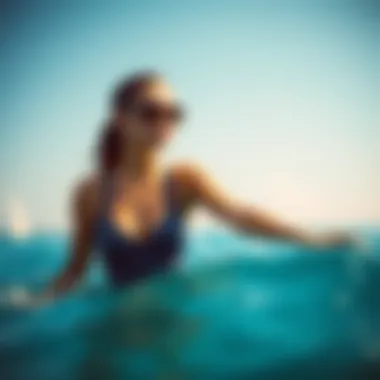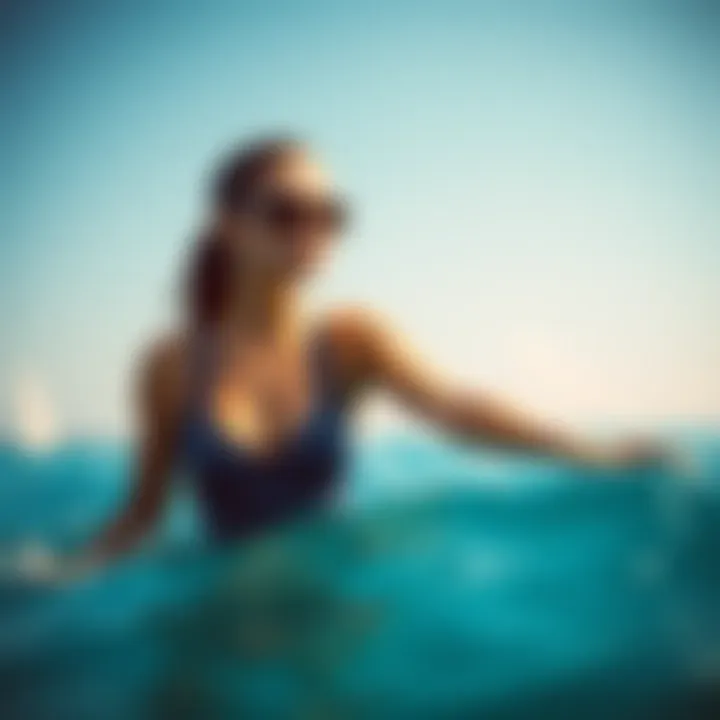Bikini Magazines: Shaping Watersports Culture and Identity


Intro
In the vibrant world of watersports, bikini magazines have carved out a significant niche, marrying seaside fashion with athletic prowess. For many, these magazines are not just pages filled with glossy images of sun-soaked models; they represent a cultural phenomenon that captures the essence of leisure, adventure, and self-expression in aquatic environments. This article delves into the interplay between bikini magazines and the watersports culture, charting their evolution, examining their influence, and exploring their role in shaping perceptions of both the activities and those who partake in them.
The roots of bikini magazines can be traced back to the mid-20th century, where swimwear began making headlines not only for its daring designs but also for the lifestyles it represented. As society progressed, so too did the portrayal of women—and men—in these pages, reflecting broader social movements. Particularly in the context of watersports, these magazines have witnessed shifts from mere fashion statements to platforms for celebrating skill, community, and inclusivity within the aquatic realm.
Importantly, it’s essential to understand how these publications impact the image of watersports. They contribute to the ongoing narrative of what it means to engage with water-based recreation, often highlighting the gears and techniques required for those ready to embrace the water. By weaving together stories of athletes, adventurers, and everyday enthusiasts, bikini magazines go beyond just swimwear to encapsulate an entire culture.
This piece will explore the myriad implications of bikini magazines in watersports culture, touching upon their role in promoting a sense of inclusivity, representing changing aesthetic values, and ultimately influencing the perception of watersports as a whole. Dive in as we uncover how these glossy pages shape not just perceptions, but also actions and aspirations within the aquatic lifestyle.
Preamble to Bikini Magazines
Bikini magazines are more than just glossy pages filled with swimwear. They serve as a window into a unique culture that intertwines fashion, beauty, and the love for aquatic activities. Understanding the world of bikini magazines helps us appreciate the influence they wield over watersports culture, shaping societal norms and aesthetics tied to water-related leisure.
Over the decades, these publications have mirrored shifts in cultural values and trends, connecting generations of readers through imagery and narratives centered around freedom, adventure, and self-expression. As such, they play a crucial role in how individuals perceive not only swimwear but also the lifestyle that accompanies it.
Bikini magazines go beyond the superficial; they encapsulate the spirit of beach life, motion, and embracing the elements. By chronicling styles, athletes, and destinations, they paint a holistic picture that speaks to athletes eager to push their limits and enthusiasts longing for an escape from the grind of daily life.
While some may argue that bikini magazines primarily promote the commodification of women, it’s essential to consider how they can also challenge traditional notions and empower readers. Through exploring these publications, one not only gains insight into the evolution of swimwear but also recognizes their impact on sports culture and societal standards connected to fitness and aesthetics.
Defining Bikini Magazines
Bikini magazines are specialized publications focusing primarily on swimwear, particularly bikinis. They blend diverse topics such as fashion, lifestyle, travel destinations, and sometimes, watersports. These magazines are often adorned with visually striking images, showcasing models in beach settings, engaging in various water activities like surfing, snorkeling, or simply basking in the sun.
However, defining bikini magazines goes beyond the surface. The term encompasses the culture of aspiration, aesthetics, and the lifestyle these magazines project. They encapsulate an ideal, presenting images and stories that intrigue and often inform their readership about gear, trends, and hotspots for aquatic adventures.
Surprisingly, the reach of bikini magazines goes way past mere images; they convey a narrative about embracing the sea, celebrating the human form, and recognizing that each body enjoys water differently. This multicultural and multifaceted portrayal continues drawing in readers from diverse backgrounds.
Historical Context and Emergence
The first bikini magazine emerged in the post-war era, a time when societal norms began shifting. After World War II, a wave of freedom and self-expression swept through many parts of the world. The bikini, which was introduced in 1946 by designer Louis Réard, came to symbolize this newfound liberation. Bikini magazines followed suit, capturing the spirit of the times. They gained traction by highlighting not just swimwear but also the lifestyles of athletes, models, and leisure-goers.
During the 1960s and 70s, the popularity of bikini magazines surged, keeping pace with the rising interest in watersports. Increasing leisure time and disposable income allowed more people to engage in activities like surfing and sailing, highlighting the connection between the sports and swimwear culture. Major titles like Bikini and Shape introduced fitness regimes alongside swimwear, setting the stage for how magazines would influence perceptions of the female form.
The integration of photography into these publications transformed how swimwear was marketed. High-quality images showcased products in action, inviting readers to envision themselves in similar scenarios. As technological advancements in print and photography emerged, so too did the level of artistry in these magazines. This evolution echoed broader societal desires for normalization and elaboration of diverse body types and shapes in aquatic settings.
In essence, bikini magazines became cultural artifacts, marking significant trends from the 20th century through to the present. They document changes in aesthetics, body representation, and the intertwining of lifestyle with athleticism, creating a rich tapestry that reflects changing dynamics in both fashion and water sports.
Above all, the journey of bikini magazines offers valuable insights into consumer culture, diversity in representation, and the ongoing conversation about body image in all its forms.
"Bikini magazines are a mirror reflecting both the beauty of the human body and the spirit of aquatic adventure."
Cultural Significance of Swimwear Representation
Swimwear representation in bikini magazines is not just about fashion. It's a reflection of changing attitudes, societal values, and the diverse tapestry of human experience. From the moment those glossy covers hit the stands, they don't just showcase swimwear; they send out messages about body norms, trends, and even what it means to enjoy water-based leisure activities. The way swimwear is portrayed can have profound effects on public perceptions.
Shaping Perceptions of Body Image
Bikini magazines have long played a pivotal role in shaping how society views body image. Historically, slim bodies dominated the pages, which influenced many to strive for unrealistic ideals. However, in recent years, there’s been a noticeable shift. More magazines now embrace various body types, promoting the idea that beauty can come in all shapes and sizes. This reflects a broader movement advocating for body positivity.
For instance, publications like Sports Illustrated Swim have embraced models of diverse body compositions, which resonate with many readers who might feel alienated by traditional portrayals. The inclusion of these models encourages acceptance and fosters a sense of belonging among readers. Furthermore, the correlation between visible diversity and self-esteem cannot be overstated: when someone sees themselves represented, it can help them to embrace their own uniqueness.
"Representation matters, especially in voices that have long been marginalized."


Influence on Female Empowerment
Women's empowerment is intricately tied to how swimwear is depicted in the media, especially in bikini magazines. By highlighting female athletes, adventurers, and explorers dressed in fashionable yet functional swimwear, these publications challenge old stereotypes. They demonstrate that women can be both attractive and capable.
Moreover, bikini magazine features often showcase women in roles that defy traditional limitations. An article spotlighting a woman engaging in kite surfing or competitive swimming, for instance, sends a strong message that women can claim their own space in what has been traditionally male-dominated watersports. This empowerment can spur others to step outside societal norms and take on activities they might have hesitated to try due to preconceived notions.
In summary, swimwear representation in bikini magazines is of great cultural significance. It directly shapes perceptions of body image and plays a crucial role in empowering women. By challenging outdated norms and expanding the narrative of beauty and capability, these publications are practically rewriting the rules of engagement in watersports culture. As they continue to evolve, one can only imagine what new horizons they will bring.
The Evolution of Aesthetic Values
The evolution of aesthetic values in bikini magazines holds significant importance in understanding how these publications not only reflect fashion trends but also influence the broader watersports culture. This section delves into how changing perceptions of beauty, functionality, and lifestyle have shaped the visual narrative of swimwear over the years. As much as they represent swimwear choices, these magazines encapsulate societal changes, ideas about body image, and cultural dynamics.
From Traditional to Modern Designs
Bikini magazines have gone through a remarkable transformation from the early days of their inception to the present time. In the beginning, the focus was highly on traditional designs. Bikinis tended to favor modest cuts and were often linked with summer vacations at typical beach resorts. Icons like the classic Halter bikini or the simple two-piece swimsuits would grace the pages, highlighting an era where swimwear was more about flaunting a comparatively sheltered image. During this time, the aesthetic was deeply intertwined with the social norms and values of the era.
However, as women's liberation movements gained momentum, bikini designs became bolder, mirroring the desire for freedom and self-expression. Modern designs now favor varied cuts, colors, and patterns that cater to diverse personal styles. The current emphasis on inclusivity allows magazines to feature a broader array of body types, as well as designs that fit a wide range of aesthetic preferences—from high-waisted options to sporty cuts, reflecting the versatility of swimwear in active lifestyles.
Impact of Digital Media
Digital media has drastically reshaped the aesthetic landscape of bikini magazines. The rise of social media platforms such as Instagram and Pinterest has given way to increased visibility for swimming apparel. The visual-centric nature of these platforms allows for a more democratized representation of swimwear styles, where anyone with an account can show their style.
With influencers and athletes often sharing their personal takes on swimwear, magazines must adapt to keep pace with the rapidly changing tastes and trends. Content on the internet means wider reach and attracts a more diverse audience than traditional print media ever did. The aesthetic sometimes reflects trends that emerge spontaneously, rather than those dictated by established designers alone.
In summary, the trajectory from traditional to modern bikini designs, combined with the influence of digital media, illustrates a profound cultural shift that extends beyond fashion. Bikini magazines now serve as a platform for expression, showcasing the plurality of bodies and aesthetics, various lifestyles, and the elements that define the contemporary watersports culture.
"The evolution of bikini magazines is not just about swimwear; it tells the story of societal progress and acceptance."
In light of all these changes, it's clear that bikini magazines continue to play a pivotal role in evolving aesthetic values, just as they influence watersport culture, shaping how individuals engage with aquatic activities and each other.
Bikini Magazines and Watersports Culture
Bikini magazines have long held a significant foothold within watersports culture, serving not just as style guides but as important cultural documents. In today’s society, where body positivity and fashion intersect, bikini publications encapsulate more than just swimwear; they symbolize a vibrant relationship between aquatic activities and lifestyle choices. Understanding these nuances aids in appreciating how they influence the behaviors and attitudes of watersports enthusiasts.
Across different decades, the imagery and narratives within bikini magazines have mirrored changing societal values. For athletes or participants in watersports, these magazines become more than objects of aesthetic admiration; they are practically an extension of their identities, encapsulating a mix of aspiration and reality. From the glossy pages, readers can glean insights— not just about the latest bikini styles, but also about upcoming competitions, expert advice, and thrilling travel destinations that spark their interest.
Glamour vs. Performance in Watersports
The dichotomy of glamour versus performance is a prevailing theme when discussing bikini magazines in relation to watersports. On one hand, these publications highlight the glamour of figures posing against stunning backdrops, capturing the elegance of aesthetic movement on the water. Yet, on the flip side, there’s a need to recognize and celebrate performance-oriented content.
For instance, magazines like Surfer or Windsurfing Magazine feature women who are not only models but also athletes excelling in their respective sports, showcasing strength and skill above mere appearance. The aim here is to promote expertise and capability, pushing the narrative that a bikini-clad athlete is just as admirable in her prowess as in her looks. This balance is crucial—who said one can’t be both glamorous and exceptionally skilled at wakeboarding?
"In the watersport world, appearance and performance often weave together to form a single narrative, one that underscores the complete essence of the athlete."
Promotion of Watersport Activities
Promotion of watersport activities through bikini magazines encompasses a variety of pragmatic approaches. Features on specific sports like paddleboarding, surfing, or diving provide not only inspiration but also essential information on gear and locations. As readers flip through pages filled with vibrant visuals, they can catch glimpses of breathtaking spots where they might want to cast their lines or catch their next wave.
Moreover, these magazines often run contests that encourage participation; thereby building community ties among enthusiasts. Articles featuring prominent events, such as the World Surf League competitions or local beach clean-ups, imbue readers with a sense of involvement and responsibility toward water-based environments. This elevates the magazine from mere advertisements to conduits for promoting healthy sports culture.
In summary, bikini magazines shape an intricate lens through which both the aesthetic and performance aspects of watersports are intertwined. As they evolve, continuing to reflect cultural shifts and encourage participation, they capture not just a pastime, but a lifestyle deeply entwined in the aquatic world.
Inclusivity and Diversity in Bikini Magazines
In contemporary discussions about bikini magazines, the topic of inclusivity and diversity has gained prominence, reshaping the landscape of swimwear representation. Once, these publications largely catered to a very narrow archetype that favored specific beauty standards. However, the evolution of societal attitudes surrounding body image and identity has paved the way for a broader narrative. Inclusivity not only promotes a sense of belonging but also positively affects the ways different communities engage with watersports culture.


Representation of Different Body Types
One key aspect of inclusivity in bikini magazines is the representation of various body types. This shift is significant because it acknowledges that beauty does not conform to a singular model. Widely recognized platforms like Sports Illustrated have begun featuring models of varied sizes, shapes, and heights on their pages. This has not only diversified the perception of swimwear but also encouraged healthier body images among readers.
A more inclusive representation makes everyone feel seen. When diverse body types feature prominently in magazines, it sends a powerful message: all bodies are worthy of celebration, regardless of imperfections or societal standards. This shift can have tangible effects on participation in watersports, as individuals may feel more confident to engage in activities like surfing, sailing, or kayaking, knowing that they are represented.
- Embraces Variety: Different body types in bikini magazines showcase that beauty isn’t one-size-fits-all.
- Boosts Confidence: Representation can significantly enhance self-esteem, encouraging participation in various activities.
- Influences Trends: With diverse figures in the limelight, designers may pivot towards inclusive designing,
Ultimately, it creates a ripple effect that may lead to a more accepting and understanding community surrounding watersport activities.
Cultural Representation in Swimwear Advertising
Cultural representation in swimwear advertising is another critical facet of inclusivity that bikini magazines must navigate. Historically, the imagery within these magazines often drew from a limited cultural perspective. Nowadays, more brands realize the necessity of reflecting the rich tapestry of identities that exist within their consumer base. This shift fosters a sense of relevance and relatability, which is essential in an age where consumers seek authenticity.
Consider the instance of brands like Aerie, which have made concerted efforts to collaborate with individuals from various cultural backgrounds and lifestyles. Such initiatives do not merely create marketing opportunities; they strengthen communal ties among different demographics, thereby enriching the watersports culture.
- Promotion of Cultural Identity: Advertisements featuring diverse cultural backgrounds allow for the celebration of heritage.
- Increased Engagement: The more consumers see their culture represented, the more they tend to support brands that honor these identities.
- Access to Niche Markets: By also showcasing traditional swimwear from different cultures, brands can tap into new markets, attracting consumers who are eager for representation.
To quote a well-known voice in the fashion industry, "Diversity isn’t just a trend; it’s the way forward in every aspect of our society." Therefore, the inclusion of various cultural representations in bikini magazines acts not merely as a marketing strategy, but as a fundamental contributor to the ongoing evolution of watersports culture.
For further readings, you might want to check out resources from the Skinny vs. Curvy blog or articles available at Britannica discussing fashion trends.
Bikini Magazines as a Source of Information
Bikini magazines serve as valuable sources of information for a wide array of audiences interested in watersports and aquatic leisure activities. They play a crucial role in bridging the gap between fashion and functionality. For someone immersed in the watersports community, these publications provide not only a visual feast but also practical insights into gear, equipment, and more. The relevance of bikini magazines extends beyond merely showcasing swimwear; they enrich the reader's understanding of their preferred activities and the culture surrounding them.
Gear and Equipment Reviews
When it comes to watersports, having the right gear can make or break the experience. Bikini magazines often feature in-depth reviews of the latest equipment, ranging from surfboards to diving gear. This includes insightful critiques that assess performance, durability, and usability. Take, for instance, a recent review of the Quiksilver X-1 surfboard. The magazine highlighted its innovative design tailored for wave-riders of all skill levels, emphasizing how it maximizes buoyancy and control. Such reviews not only detail the pros and cons of each product but often compare them, offering readers a side-by-side look at features and pricing.
Readers can also find helpful buying guides within these publications, which aim to demystify complex gear choices. Knowing whether to choose a hard-shell or inflatable paddleboard can be critical and a feature comparing these options serves to inform enthusiasts in a digestible format.
Additionally, testimonials from professional athletes often accompany these reviews, lending credibility to the claims made about various products. This right blend of expert opinion and user experience informs readers, helping them to make decisions aligned with their own needs and aspirations in the watersports realm.
Travel Destinations for Watersports Enthusiasts
Bikini magazines don't stop at gear reviews; they sensationally offer an array of travel suggestions for watersports enthusiasts. Featured articles often include breathtaking locales that are tailored to specific activities. For example, a spotlight on the beaches of Bali may detail the perfect surfing spots, mentioning names like Uluwatu and Kuta as prime destinations to catch waves. Insights into local culture, environmental conditions, and seasonal variables often accompany these discussions, aiding readers in planning their trips effectively.
Moreover, readers can discover hidden gems through destination guides that go beyond the usual tourist traps.
- Lesser-known beaches in Mexico, suitable for kitesurfing, could be bundled together with top resorts to ensure a seamless holiday experience.
- Similarly, guides might emphasize eco-conscious resorts that promote sustainability, aligning with the growing trend towards ethical travel.
“Travel is more than just a destination; it’s an experience that allows us to connect with nature.”
Such articles not only invite adventure but also spark curiosity about the rich tapestry of cultures and practices that surround watersports. This information encourages enthusiasts to engage deeply with their hobbies while exploring the world around them.
In summary, bikini magazines act as enlightening compendiums for watersports culture. They combine the glamour of swimwear with substantive content to help readers navigate the watersport scene proficiently, whether by selecting the right gear or planning an unforgettable coastal excursion.
Market Trends in Bikini Publications
Bikini magazines have long been a staple in the realm of watersports culture, providing not just a showcase for swimwear, but a vibrant lens through which to view market dynamics and consumer preferences. Understanding market trends is crucial for various stakeholders, including athletes, coaches, travel agents, and even educators aiming to inspire the next generation of watersport enthusiasts. With a comprehensive exploration of sales trends and the impact of social media on print publications, this section aims to shed light on significant shifts and highlight relevant insights that can guide future strategies.
Sales Trends and Demographics
Sales trends in bikini publications reflect broader societal changes. As the popularity of watersports grows, so too does the demand for specialized magazines that cater to this vibrant community. Over the years, there has been a noticeable uptick in subscriptions and single-issue sales for magazines like Sports Illustrated Swimsuit Issue and Bikini magazine.


The demographics of the readership have shifted as well. Initially dominated by young women, the audience has expanded to include a more diverse group, appealing to all ages and gender identities. Understanding these demographics helps advertisers tailor their messages and products more effectively. Here are some noteworthy observations:
- Age Range: Many bikini magazines now cater to readers aged 18-35, yet there's increasing interest among older demographics who desire stylish, functional swimwear.
- Gender Dynamics: While female readers remain a core audience, an increasing number of men engage with these publications, seeking inspiration and tips related to watersports and swimwear.
- Regional Influence: Trends in sales often vary by region, reflecting localized preferences in swimwear styles and cultures associated with water activities.
This evolution in reader identity has compelled brands to diversify their advertising strategies and develop products that reflect various lifestyles.
Impact of Social Media on Print Publications
The rise of social media profoundly transformed the landscape for bikini magazines. Platforms like Instagram and TikTok now serve as vital channels for bikini brands, allowing them to reach audiences in real-time. Print publications have had to adapt accordingly. The instant and highly visual nature of social media heightens competition for attention, often leading to a decline in traditional print sales. Here are some key impacts:
- Brand Engagement: Engaging with audiences through platforms allows for immediate feedback and interaction, creating communities around brands that traditional print mediums cannot replicate.
- Content Collaboration: Split screen with prominent athletes and influencers further blurs the lines between print and digital. Collaborations between brands and online personalities increase visibility, often leading to higher consumer engagement.
- Visual Storytelling: The aesthetic quality of swimwear is now often showcased through high-resolution photographs and videos that social media best facilitates. This shift has prompted magazines to invest in more professional visuals, reflecting the quality that digital platforms demand.
"Social media is not just an extension of bikini magazines; it's reshaping how we understand and market swimwear in today's world."
In summary, the interplay between print publications and social media illustrates the shifting landscape of bikini magazines. As these magazines evolve, they adapt by reconciling traditional values with modern marketing strategies, ensuring they remain not just relevant, but integral to the future of watersports culture.
The Future of Bikini Magazines
The future of bikini magazines stands at a critical crossroads, reflecting broader trends in fashion, sustainability, and technology. As we look ahead, it's essential to ponder how these elements will shape not only the magazines themselves but also their influential role within the watersports culture. With growing awareness around environmental issues and the impact of the fashion industry, readers today demand more than just aesthetics from their favorite publications. They seek genuine engagement with the pressing issues of sustainability and ethical practices, which ultimately affects their purchasing decisions and loyalties.
Moreover, as technology evolves, so do the platforms through which we consume content. The traditional print model faces challenges with digitization forcing a shift in consumer preferences. Magazines must adapt to these trends, integrating innovative technology into their publication processes and outreach strategies. This not only means rethinking advertising approaches but also exploring how social media and online platforms reshape reader engagement.
Sustainability and Ethical Fashion
Sustainability in fashion is no longer just a buzzword; it has become a requisite for brands and publications striving to stay relevant in this rapidly changing market. Bikini magazines must reflect this imperative, emphasizing not just glamorous swimwear but also sustainable materials and production processes. Publications that prioritize ethical fashion resonate with audiences increasingly concerned about their carbon footprint and the environmental impact of their purchases.
Consider how brand collaboration with sustainable swimwear labels, such as Patagonia or Aerie, not only supports eco-friendly practices but also resonates with consumers who appreciate transparency in garment production. Bikini magazines can highlight stories of brands actively working towards reducing waste and promoting fair labor practices. By incorporating discussions about sustainable fabric technologies, like recycled polyester or organic cotton, these magazines not only inform their readers but also empower them to make conscious choices about the swimwear they buy.
Furthermore, readers are more inclined to engage with magazines that showcase diverse body types, which is directly tied to the evolving conversation around inclusivity. This isn’t just about representation for representation's sake; it’s about fostering a genuine culture of acceptance and self-love.
The Role of Technology in Publication
Technology's imprint on bikini magazines is undeniable and multi-faceted. While the shift toward digital has prompted many to question the viability of print, it simultaneously opens doors to opportunities for creative storytelling. Interactive elements, augmented reality experiences, and engaging video content can provide deeper, richer experiences that print alone cannot offer.
For instance, flip through your favorite bikini magazine on a tablet or smartphone, and you might find interactive advertisements that allow you to see swimwear choices via virtual fitting rooms. This is not just a convenience; it's a revolution in how consumers interact with brands, making the shopping experience more personalized and efficient.
Integration with social media platforms allows magazines to expand their reach, drawing in diverse audiences and encouraging user-generated content. When readers engage with magazines through online platforms, sharing their own aquatic adventures and experiences, it creates community and fosters loyalty. With dynamic content capabilities, magazines can swiftly pivot to trends or audience feedback, ensuring they stay at the forefront of the discussion.
To encapsulate, the future of bikini magazines hinges on their ability to evolve. By embracing sustainability and leveraging the potential of technological advancements, bikini publications can continue to play an influential role in shaping watersports culture. The tide is turning, and those willing to adapt will ride the waves of change successfully.
Closure
Bikini magazines have evolved from simple fashion publications into crucial players within the watersports culture. Their importance transcends the pages, influencing perceptions, behaviors, and the overall identity of aquatic enthusiasts. Examining the findings throughout this article, we see that the interplay between fashion and function has far-reaching implications for participants in watersports.
Summary of Findings
The evolution of bikini magazines mirrors broader cultural shifts and reflects changing values surrounding body image, empowerment, and inclusivity. Notably:
- Cultural representation in these magazines has encouraged a more diverse range of swimwear, catering to different body types and cultures. This underscores a growing acceptance within the realm of aquatic activities.
- Bikini magazines act as tools for promoting watersports, showcasing not only the glamorous side through stunning visuals but also providing practical information about gear and activities.
- Digital media's rise has transformed how these publications operate, pushing traditional print models to adapt and reinvigorate their approach toward audience engagement.
"The presentation of swimwear in media is not merely about aesthetics; it's indicative of social norms and the evolving narrative surrounding our bodies in aquatic activities."
These components illustrate the significant foundation bikini magazines lay for the future of watersports, entwining fashion with passion and functionality.
Final Thoughts on Bikini Magazines and Watersports
In wrapping up the exploration of bikini magazines within watersports culture, it becomes clear that these publications are more than just eye candy. They serve as founts of knowledge, support communities, and drive conversations about inclusivity and empowerment. The ongoing dialogue sparked by changes in aesthetic values and representation is crucial in shaping future trends.
As the industry moves forward, embracing sustainability and ethical concerns is paramount. The combined synergy of fashion, functionality, and purpose in bikini magazines continues to inspire a new generation of watersport lovers. This evolution reflects not only a shift in how we view swimwear but also how we engage with our aquatic environment.
Ultimately, bikini magazines will remain significant as they champion the lifestyle of watersports enthusiasts, pushing boundaries and redefining norms while celebrating the beauty and diversity of life on the water.















